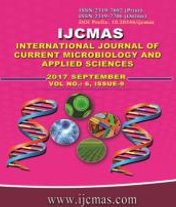


 National Academy of Agricultural Sciences (NAAS)
National Academy of Agricultural Sciences (NAAS)

|
PRINT ISSN : 2319-7692
Online ISSN : 2319-7706 Issues : 12 per year Publisher : Excellent Publishers Email : editorijcmas@gmail.com / submit@ijcmas.com Editor-in-chief: Dr.M.Prakash Index Copernicus ICV 2018: 95.39 NAAS RATING 2020: 5.38 |
This study sobers the penchant searches on sustainable rice production systems. Three aspects of different rice cultivation, carbon footprint, water productivity, and Energy efficiency were analysed. GHG emissions from rice cultivation estimated are CH4, N2O and CO2.Three rice cultivation systems SRI (System of Rice Intensification), AWD (Alternate Wetting and Drying) and conventional were selected which differ in agronomic and water management practices. The gas samples were collected using static closed chamber and was analysed using a gas chromatograph equipped with FID. Water irrigated to the field was measured in m3 using a water meter. The estimates of carbon footprint were prepared using the global warming potential of the above GHGs as suggested by IPCC. The results indicates that SRI method of cultivation recorded less carbon footprint of 0.491 kg CO2 eq. /kg of dry matter with higher yield 10.82 t and water 1.69 kg/m3.
 |
 |
 |
 |
 |